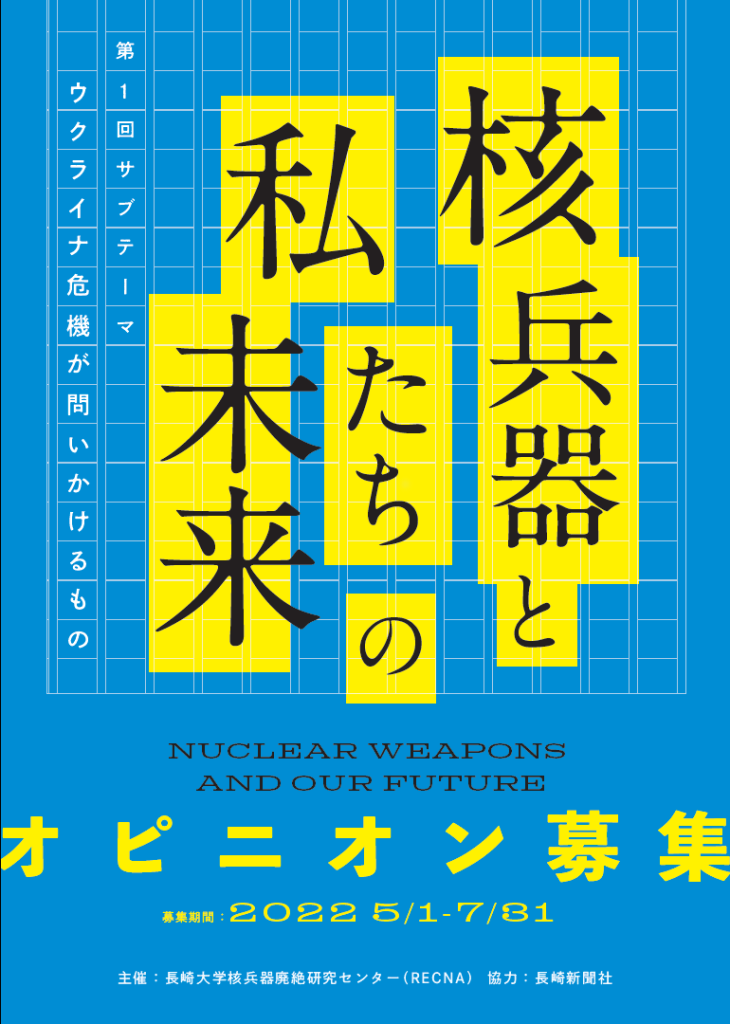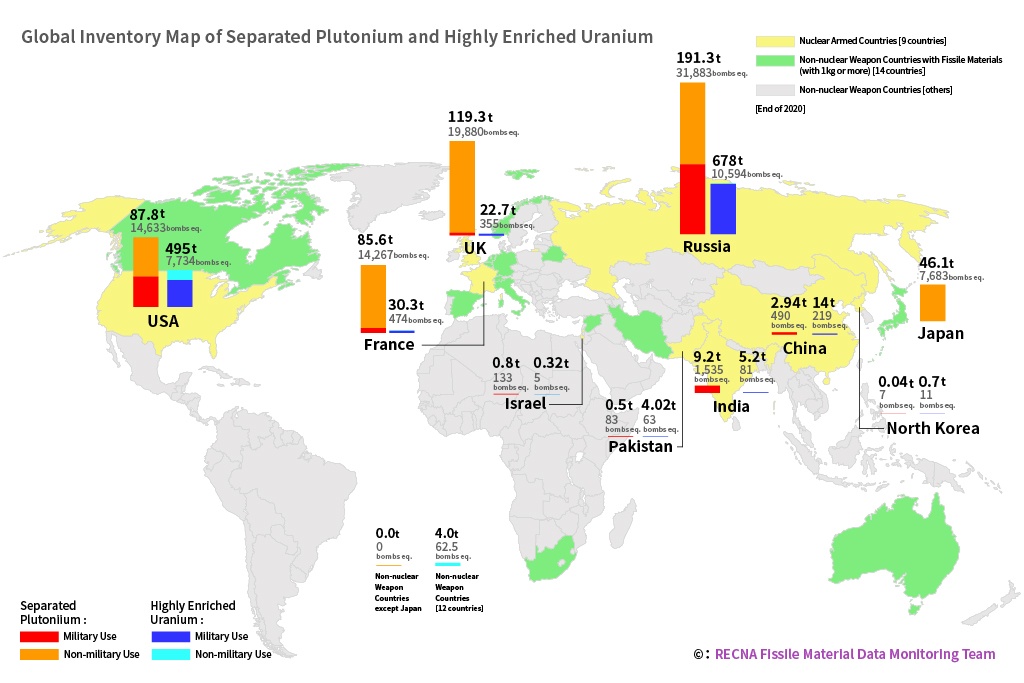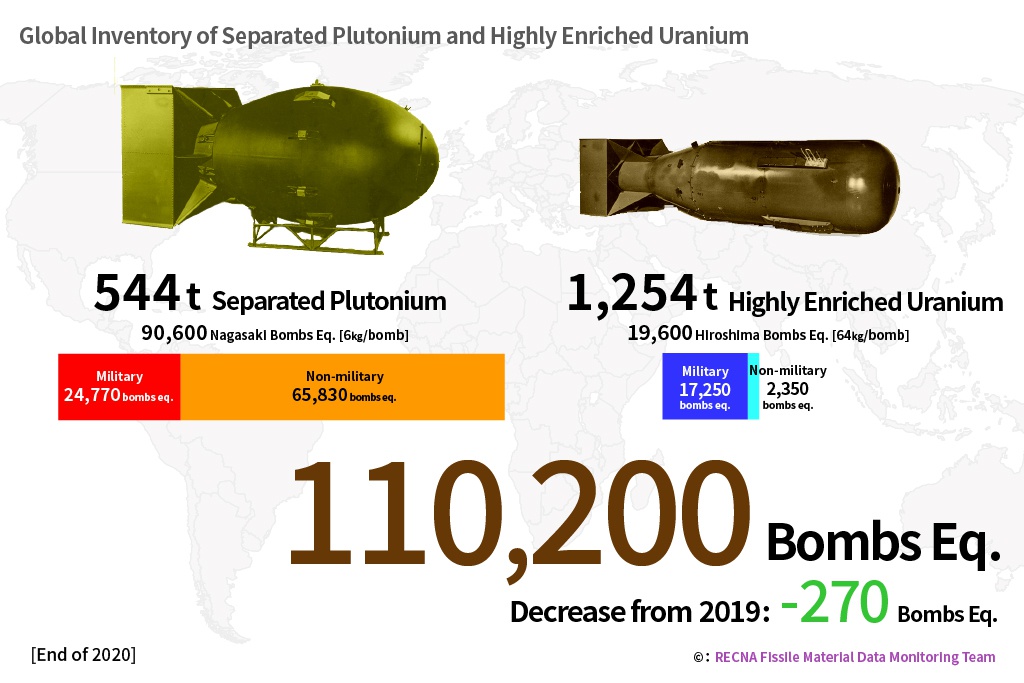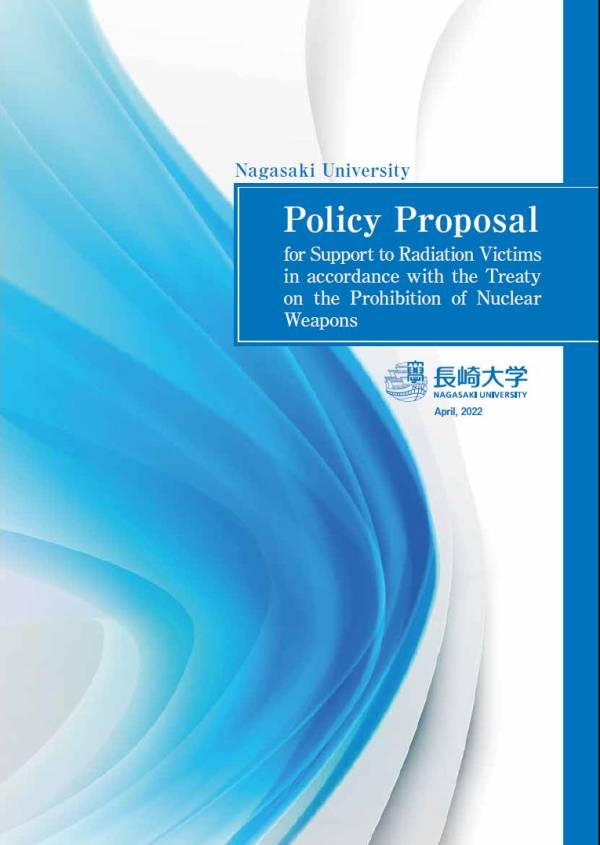Winners of the First Essay Contest Announced [JPN]
The Research Center for Nuclear Weapons Abolition, Nagasaki University (RECNA) held a call for “opinions” applying to the First Essay Contest on “Nuclear Weapons and Our Future” as one of its 10th anniversary commemorative projects, with the aim of raising awareness of the importance of nuclear weapons issues among the younger generation and fostering human resources who can contribute to the realization of a peaceful international society.
One Grand Prize winner and two Second Prize winners have been selected, and the winners were announced and the Award Ceremony (photos) was held as follows.
The best “opinion” was published in the print version of Nagasaki Shimbun Newspaper on September 25, 2022. This is an article (in Japanese) of the electronic version.
【 Winners: 1 Grand Prize Winner, 2 Second Prize Winners 】
Grand Prize |
Kokoro Nishiyama(23 years old)
Master’s course at Middlebury Institute of International Studies, Monterey, USA |
|
|---|---|---|
Second Prize |
ALOK CHANDAN(26 years old)
PhD Candidate, Department of East Asian Studies, University of Delhi, India |
|
Second Prize |
Keisuke Aoki(29 years old)
Lives in Tokyo. Company Employee. |
【 9 Finalists excluding winners / 54 Total Applicants 】
【 Award Ceremony 】
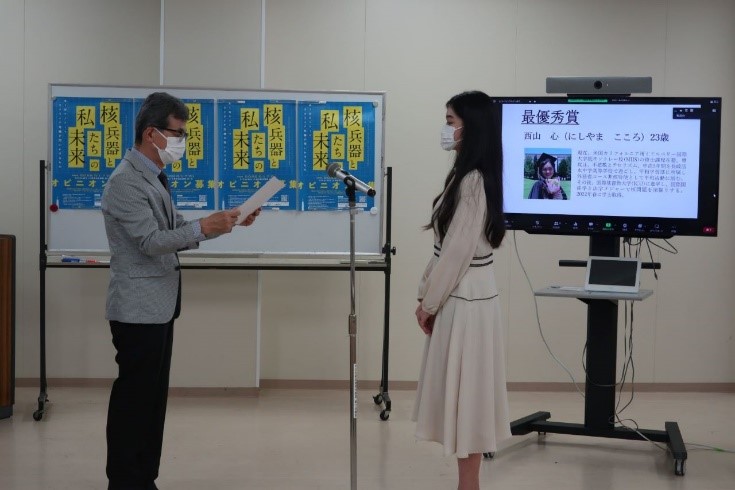 |
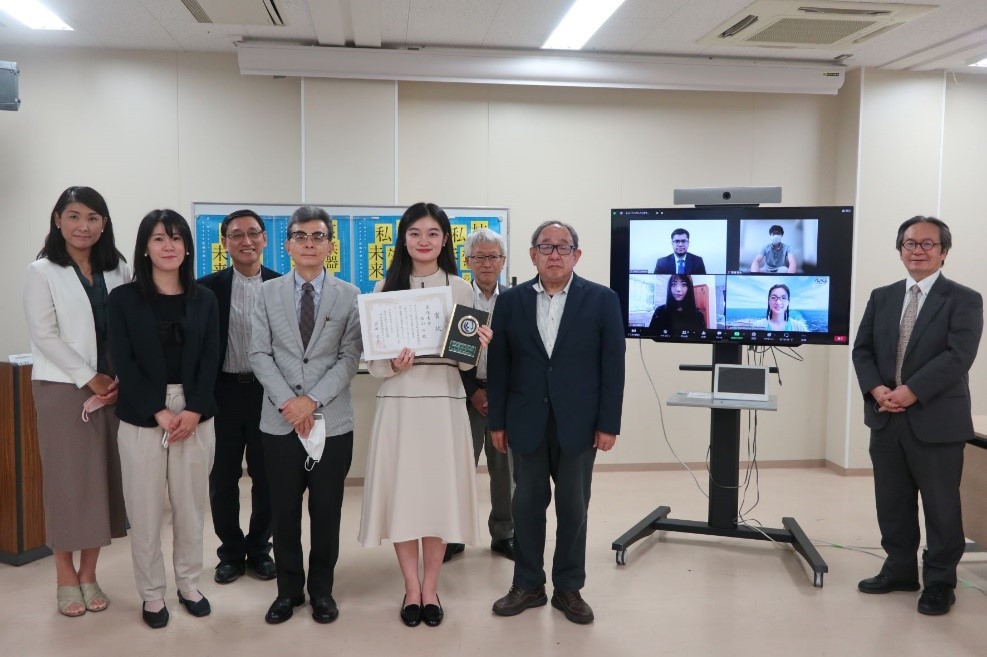 |
|
| Awarding of the Grand Prize | Attendees of the Award Ceremony |
| DATE/TIME: |
Saturday, September 24, 2022 Award Ceremony: 13:00-14:00 Press Conference: 14:00-14:30 |
|---|---|
| VENUE: | Nagasaki University |
| PROGRAM: |
1. Opening Remarks (Dr. Shirabe, Chairman of the Executive Committee for the 10th Anniversary Projects) 2. Announcement of winners, presentation of award certificates & plaques Announcement of the Second Prize winners (Prof. Seirai, Chair of the Selection Committee) Speeches by the Second Prize winners Announcement of the Grand Prize winner (Prof. Seirai) Speech by the Grand Prize winner 3. Comment on the awarded essays (Prof. Seirai) 4. Comments by the other members of the Selection Committee (Prof. Ishida, Ms. Kojima, Ms. Hatakeyama, Ms. Matsunaga) 5. Closing Remarks (Prof. Yoshida, Director of RECNA) Photo Session |
| PRESS CONFERENCE: |
Speakers: Prof. Seirai, Award winners Prof. Suzuki (Moderator), interpreter |
“World’s Fissile Material Data” 2022 [All Lists]
The 2022 World’s Fissile Material Data have been published. The above two images can be enlarged by clicking on them. You can also view and download the following PDF versions.
・The 2022 Global Inventory Map of Fissile Material
・The 2022 Global Inventory of Fissile Material
The special feature of this year’s map is that for the first time since we started the publication the aggregate amount has diminished. This is in particular due to the large decline in the amount of highly enriched uranium (HEU) but the amounts of plutonium continue to follow an upward trend. A major drop in the amount of HEU was due to reductions by the US in its military-use HEU and reductions in the amounts in the possession of non-nuclear countries, an amount of 76 tons (equivalent to about 1,220 warheads). The overall rising trend in plutonium continues and although the amount of military-use plutonium has not increased much, the amount of civilian use plutonium in the non-military category (held mainly by France and Japan) rose, leading to a slight increase of the overall amount of plutonium (totaling 6 tons, equivalent to around 950 warheads).
◆ You can see the original data of the map from the following links.
・Global Inventory of Separated Plutonium
・Global Inventory of Highly Enriched Uranium
◆ You can see previous “World’s Fissile Material Data” from [All Lists].
◆ The 2022 World’s Nuclear Warheads Data have been published too. You can see them from here.
THE CROSSROADS OF ATOMIC WARFARE IN ONE FAMILY
Michael Roach
August 6, 2022
This report is published under a 4.0 International Creative Commons License the terms of which are found here.
This report is simultaneously published by the Asia-Pacific Leadership Network, Nautilus Institute, and the Research Center for Nuclear Weapons Abolition, Nagasaki University (RECNA).
The views expressed in this report do not necessarily reflect the official policy or position of the Nautilus Institute. Readers should note that Nautilus seeks a diversity of views and opinions on significant topics in order to identify common ground.
In this photo-essay, Michael Roach provides a remarkable account of multigenerational involvement in nuclear war, including a previously unpublished photo of the starboard nose of the Enola Gay bomber that delivered the first atomic bomb and returned to Tinian airfield, showing the inscription “First Atomic Bomb – Hiroshima – August 6, 1945.” Michael Roach and his father, Kenneth Roach, both served in the US Army two decades apart on missions that involved the atomic bomb. The prospect of real atomic warfare in Japan during the 1940s, and potential atomic warfare in Korea during the 1960s, brought their lives together historically, but father and son came away from their experiences with completely different conclusions. This essay sheds light on the US government’s thinking about nuclear weapons, particularly vis-à-vis military operations in Northeast Asia. It outlines the impracticality and risks of the US strategy to use tactical atomic weapons in Korea in the 1960s.
Keywords:
Atomic warfare, United States, Northeast Asia, Hiroshima, tactical atomic bomb
Authors’ Profile:
Michael Roach is a retired renewable energy manager residing in a small Wisconsin farm town surrounded by vast green fields of corn and soybeans. He is currently writing a history of wheat culture using commodity chain analysis. His research is part of a larger project that examines the history of illumination and power technologies, from 18th century whale oil to modern microgrids. He also volunteers his time assisting in the reconstruction of Ukraine using ultra energy efficient modular multifamily housing powered by solar microgrids. He served in US Forces Korea as an Atomic Demolition Munitions engineer in 1968.
Dr. Masao Tomonaga, Visiting Professor of RECNA, gave a speech at the First Meeting of States Parties to the U.N. Treaty on the Prohibition of Nuclear Weapons in Vienna on June 22. The manuscript provided by the author is posted bellow.
Hibakusha Story by a Nagasaki Hibakusha
Masao Tomonaga
Honorary Director, Atomic Bomb Red Cross Hospital in Nagasaki
[ Japanese Translation ] [ UN Web TV 01:16:35~ ]
I am a Nagasaki hibakusha encountered the second atomic bomb at 2.5 km from the hypocenter. I was 2 years old. I survived in a crushed Japanese wooden house from which my mother then 20 years old took me out of the broken house. Our area was soon burnt out, getting into completely flat field.
I have no memory of this disaster I encountered. I had no acute symptoms and grew up normally. When I became a high school boy it was the time when leukemia took place at high incidence especially among young Hibakusha. This makes me anxious, I decided to become a physician. I entered Atomic Bomb Disease Institute, Nagasaki University in 1968, since then I continued my research for over 45 years. I observed high incidence of leukemia until 1970ies and the cancer of various organs then followed and continued even until now. Some hibakusha are developing second and third cancers. Thus, the cancer occurrence covers whole life of Hibakusha. Four years ago, finally, I myself suffered from prostate cancer and I’m now under chemoradiotherapy. Thanks to this modern therapy I am enjoying now good health.
We hibakusha never had a calm period relieved from the long-lasting anxiety of cancers and other diseases. We have overcome always such atomic bomb-related obstacles to re-construct our life.
Recent statistics shows an increased incidence of heart attack among aged hibakusha, that is myocardial infarction. Atomic bomb radiation may induce genetic damages, that is DNA damage, to induce not only cancers and leukemia but also cardiovascular disorders. Whole life of hibakusha can be described as a non-stop train, slowly progressive deterioration of their health during their struggle to reestablish their family and houses, that is a resurrection for new life after the bombing. Some hibakusha lost their parents or siblings who were also hibakusha due to cancers, for female hibakusha segregation was severe in finding their partners. Such segregation was especially severe in early period of 20 years after bombing, but later decreased after most hibakusha could establish their own families.
Children born to hibakusha and their parents then encountered a special type anxiety that they might develop malformation or cancers due to genetic transmission from their parents. Such anxiety has been enhanced all the way until now because of the lack of scientific evidence for genetic transmission although animal experiments had often reported positive clear results. Recently my school Nagasaki University Atomic Bomb Disease Institute established a new molecular technique to prove genetic transmission of radiation-induced genetic abnormalities from fathers’ sperm cell and mother’s ova cells to their children. This technique is called whole genome sequencing. The first trial of this molecular analysis using three pairs of high-dose exposure parents and their children ended in negative results. This technique might be the last and determinative one to draw a conclusion in this genetic matter of atomic bone radiation on human being. Our hibakusha population is in the final stage of constant shrinkage. In their final stage of hibakusha life they were very happy to see TPNW finally established in 2017 and got into power in 2021. However, we hibakusha has deeply disappointed to the fact 9 nuclear states and over 30 states which depend on nuclear weapons of allied states, especially Japan as only atomic bomb affected nation in the world is being protected by the nuclear umbrella from the allied nation, USA. We feel very sad for our country Japan depends on the nuclear weapons: We are crying.
We feel very sad to see this dilemma and high wall we need to overcome to realize a nuclear-free world before all hibakusha die and disappear from the world. Before leaving our life as hibakusha, the first human being encountered the first and second atomic bomb attack would like again to say the bombings were indiscriminative without prewarning, during work time for detonation, the selection of two cities as targets were suitably populated to examine the effect of atomic bombs on human beings, We ask world citizens to understand our life seriously. Especially we would like to pray for not seeing the genetic radiation effect over to our descendants.
Finally, I again emphasize that TPNW states parties must give strongest pressure to the nuclear weapon states to sign and join TPNW. Taking the opportunity of the coming NPT Review Conference TPNW groups must negotiate with nuclear weapon states and other nuclear dependent countries such as my country Japan to start dialogue and to have a track 1.5 meeting with non-nuclear weapon states and international NGOs such as ICAN. Hibakusha NGOs in Nagasaki recently established new organization with peace-promoting groups to restart our campaign to talk with those citizens who live in the nuclear weapon states and give lessons on our experience in 1945 and subsequent long-term consequence of antihumanitarian effects on human beings.
I stop my talk here, thank you for attention.
Research Center for Nuclear Weapons Abolition, Nagasaki University (RECNA) issued Statement on July 8, 2022.
Statement on the Research Center for Nuclear Weapons Abolition, Nagasaki University (RECNA) Welcomes German Foreign Minister’s Visit to Nagasaki
Research Center for the Nuclear Weapons Abolition, Nagasaki University (RECNA)
July 8, 2022
H.E. Ms. Annalena Baerbock, Federal Minister for Foreign Affairs of Germany, will visit Nagasaki on July 10, the Prefecture and the City of Nagasaki announced. The visit precedes her meeting with Foreign Minister Yoshimasa Hayashi in Tokyo. In Nagasaki, her visit to the Nagasaki Atomic Bomb Museum, offering flowers at the Nagasaki National Peace Memorial Hall for the Atomic Bomb Victims, and meeting with a hibakusha, an Atomic Bomb survivor, have been scheduled. As the crisis in Ukraine raises concerns about the use of nuclear weapons, it has become increasingly important to focus attention on such weapons’ inhumanity. As an academic center in the A-bombed city, RECNA sincerely welcomes her visit.
Germany attended the First Meeting of States Parties to the Treaty on the Prohibition of Nuclear Weapons (TPNW), held in Vienna from June 21 to June 23, as an observer country. Together with the Netherlands, Norway, and Belgium, Germany was one of the few member states of the North Atlantic Treaty Organization (NATO), which is a self-declared “nuclear alliance,” to participate the meeting as an observer.
In his statement issued at the meeting1, the German ambassador noted the importance of the “humanitarian perspective” and reiterated his country’s commitment to “engaging in constructive dialogue and exploring opportunities for practical cooperation.” He also stressed that “broader attention and engagement” should be given to the issue of “victim assistance and environmental remediation” stipulated in Articles 6 and 7 of the TPNW. As the “Vienna Action Plan” adopted by the States Parties of the TPNW calls for greater dialogue and cooperation with states outside of the treaty, Germany’s positive stance gives hope for new developments in the future. We hope that Germany will be a leader in drawing the nuclear armed states and countries under the nuclear umbrella, including Japan, to “constructive dialogue.”
Germany, together with Japan, as core states of the “Non-Proliferation and Disarmament Initiative (NPDI)” and the “Stockholm Initiative for Nuclear Disarmament,” have an important role to play in determining the success of the NPT Review Conference to be held from August 1 to August 26. We look forward to further initiatives and actions by Germany to advance nuclear disarmament. Next year, Japan takes over the G7 Presidency and the summit will be held in Hiroshima. We hope that Germany, which holds this year’s Presidency, will strengthen its cooperation with Japan so that the G7 Heads of State and Government can demonstrate their strong will to realize a “world without nuclear weapons” at the Hiroshima summit. As part of this effort, we strongly request that the Meeting of the G7 Foreign Ministers be held in Nagasaki as an opportunity to further expand awareness of the inhumanity of nuclear weapons.
1https://documents.unoda.org/wp-content/uploads/2022/06/Germany.pdf
“World’s Nuclear Warheads Data” 2022 [All Lists]
The 2022 World’s Nuclear Warheads Data have been published. Please click on the following thumbnail images and download the pdf posters.
| Japanese | English | Korean | |
| Jun. 2022 | 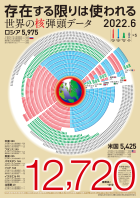 |
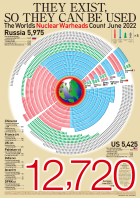 |
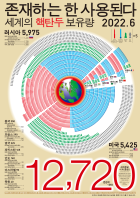 |
◆ You can see previous “World’s Nuclear Warhead Data” from [All Lists].
◆ The 2022 World’s Fissile Material Data have been published too. You can see them from here.
Research Center for Nuclear Weapons Abolition, Nagasaki University (RECNA) issued Statement on May 25, 2022.
Statement on the “Japan-U.S.” and “ROK-U.S.” Joint Leaders’ Statements:
From the Perspectives of Denuclearization of Northeast Asia and Nuclear Disarmament
Research Center for the Nuclear Weapons Abolition, Nagasaki University (RECNA)
May 25, 2022
The Republic of Korea (ROK)-United States Joint Statement1 and the Japan-U.S. Joint Statement2 were issued on May 21 and 23, 2022, respectively. They were both comprehensive statements covering a wide range of topics, including not only security and alliance relations, most notably related to the Ukraine crisis, but also economic security, climate change, and pandemics. The following are RECNA’s views on some of the most noteworthy points of these statements from the perspective of the denuclearization and security of Northeast Asia, as well as nuclear disarmament and non-proliferation.
1. Denuclearization of the Korean Peninsula: Needs for confidence-building and a new security framework for the entire region
Both the ROK-U.S. and Japan-U.S. Joint Statements confirmed their commitments to the “denuclearization of the Korean Peninsula.” How to move it forward will be even more important from now on, and RECNA believes that it is essential to strengthen diplomacy toward stability and peace on the Korean Peninsula, carrying on the spirit of the U.S.-Democratic Republic of Korea (DPRK) Joint Statement issued at the Singapore Summit3. To this end, it is necessary to continue efforts for confidence-building and dialogue throughout Northeast Asia, including with China and Russia, and to propose a new security framework. Establishing a framework for disarmament and arms control is also indispensable, because security and disarmament/arms control are deemed to be paired and inextricably linked. In addition, diplomatic efforts should be made to ease tensions beyond “confrontation,” including humanitarian assistance to the DPRK, which is now facing a pandemic crisis. The DPRK should acknowledge that its very best policy is to exercise restraint in its nuclear and missile tests and embark on the path of dialogue.
The joint statements included strengthening extended deterrence and response capabilities to respond to the threats posed by the DPRK, China, and Russia, but, contrary to the intention, placing too much emphasis on this direction is fraught with the risk of further increasing tensions in the region. Thus, we demand the relevant countries constantly recognize the need for communication and dialogue at the leadership level, as indicated by the joint statements, and reconsider diplomatic strategy for averting a crisis.
2. Nuclear disarmament and non-proliferation: Strengthening the norm of “non-use of nuclear weapons
Although not included in the ROK-U.S. Joint Statement, the Japan-U.S. Joint Statement is commendable in that it confirms the intent toward a “world without nuclear weapons” and clearly states the strengthening of the Treaty on the Non-Proliferation of Nuclear Weapons (NPT), the increase of transparency, and nuclear risk reduction, the latter of which has been recognized as more of a reality due to the Ukrainian crisis. However, compliance with NPT Article VI was not included. In preparation for the NPT Review Conference to be held in August this year, we would like to reiterate our appeal to the nuclear weapon states to strengthen the norm of “non-use of nuclear weapons” in accordance with the joint statement of the leaders of the five nuclear weapon states released on January 3, 20224, which affirmed that “a nuclear war must never be fought.”
3. Holding the G7 Summit in Hiroshima: Starting a new trend of nuclear disarmament from the A-bombed city
As an academic body in an A-bombed city, we greatly welcome the announcement at the joint press conference5 that the decision had been made that the G7 summit would be held in Hiroshima in 2023. This will be an excellent opportunity to stem the tide of the nuclear arms race and create a new trend toward nuclear disarmament. From the A-bombed city of Hiroshima, it is hoped that the leaders of the G7 nations will make appeals to the world about the “inhumanity” of nuclear weapons and the reality of the atomic bombings, and show their renewed determination toward a “world without nuclear weapons.”
1“U.S.-ROK Leaders’ Joint Statement”, May 21, 2022. https://www.whitehouse.gov/briefing-room/statements-releases/2021/05/21/u-s-rok-leaders-joint-statement/
2“Japan-U.S. Joint Leaders’ Statement: Strengthening the Free and Open International Order,” https://www.mofa.go.jp/mofaj/files/100347252.pdf
3 “Joint Statement of President Donald J. Trump of the United States of America and Chairman Kim Jong Un of the Democratic People’s Republic of Korea at the Singapore Summit”, June 12, 2018. https://trumpwhitehouse.archives.gov/briefings-statements/joint-statement-president-donald-j-trump-united-states-america-chairman-kim-jong-un-democratic-peoples-republic-korea-singapore-summit/
4“Joint Statement of the Leaders of the Five Nuclear-Weapon States on Preventing Nuclear War and Avoiding Arms Race,” January 3, 2022. https://www.whitehouse.gov/briefing-room/statements-releases/2022/01/03/p5-statement-on-preventing-nuclear-war-and-avoiding-arms-races/
RECNA Policy Paper (REC-PP-13) “核戦争に勝者はありえず、核戦争は決して戦ってはならない-5核兵器国首脳共同声明の意義と課題(“There are no winners in nuclear war. Nuclear war cannot be won and must never be fought: Significance and challenges of the joint statement of leaders of five nuclear weapon states”), March 2022, https://www.recna.nagasaki-u.ac.jp/recna/bd/files/REC-PP-13.pdf (Japanese only)
5「来年のG7サミット、広島で開催へ 日米首脳会談でバイデン氏賛同 (“G7 Summit next year will be held in Hiroshima. Agreed by Biden at the Japan-U.S. Summit”」, Asahi Shimbun, May 23, 2022, https://digital.asahi.com/articles/ASQ5R4R2CQ5RUTFK00Y.html
Journal for Peace and Nuclear Disarmament (J-PAND) has published a supplement issue on Reducing the Risk of Nuclear Weapons Use in Northeast Asia (NU-NEA).
For NU-NEA project, see here.
First Essay Contest on “Nuclear Weapons and Our Future” in commemoration of the 10th Anniversary of RECNA [JPN]
The Application submission period was over.
Thank you for your many submissions!
The award winners will be announced on September 24th on the RECNA website.
For the First Essay Contest on “Nuclear Weapons and Our Future” in commemoration of the 10th Anniversary of the Research Center for Nuclear Weapons Abolition, Nagasaki University (RECNA)
Young people between the ages of 16 and 29 are invited to submit an essay on “Nuclear Weapons and Our Future.” The sub-theme for 2022 is “What lessons should we learn from the crisis in Ukraine?” Please feel free to write your thoughts and innovative ideas.
Awards will be given for outstanding essays. One grand prize winner will participate in the award ceremony in Nagasaki on Saturday, September 24, 2022. A winner who resides within Japan will be invited to participate in person. If the winner resides overseas, he or she will be asked to participate online. The winning essays will also be published in the Nagasaki Shimbun newspaper.
| Eligibility |
|---|
|
• Ages between 16 and 29 (as of July 31, 2022) |
| Applications |
|
Please submit the following documents in PDF format by e-mail to opinion@ml.nagasaki-u.ac.jp
1. Application form |
| Submission Deadline; July 31, 2022 |
|
You will receive a notice of receipt approximately one week after submission. If you do not receive a notice please contact us at the contact information below. |
ABOUT THE PRIZE
• Grand prize winner (one person) will receive a commemorative plaque, prize money of 50,000 yen, and, for a winner who resides in Japan, an invitation to the award ceremony in Nagasaki. (A winner who resides outside Japan will be invited to participate online.) A Nagasaki Peace Tour will be arranged for those who wish to participate.
• Second prize winners (two persons) will receive a commemorative plaque and prize money of 30,000 yen.
AWARD SELECTION AND ANNOUNCEMENT
One Grand prize winner and two Second prize winners will be selected after strict screening by the selection committee. The committee members are:
• Yuichi SEIRAI, Akutagawa Award-winning author, visiting professor of RECNA (Chair)
• Kenji ISHIDA, Editorial Director, Nagasaki Shimbun newspaper, visiting professor of RECNA (Vice chair)
• Keiko NAKAMURA, Associate Professor of RECNA (Vice chair)
• Mei KOJIMA, NHK (Japan Broadcasting Corporation) Nagasaki, reporter
• Tatsujiro SUZUKI, Vice Director of RECNA, professor
• Sumiko HATAKEYAMA, staff member of Peace Boat
• Ruiko MATSUNAGA, peace activist
| Screening Criteria |
|---|
|
Your Essay will be evaluated on the following criteria: (1) Clarity, (2) Logical consistency, (3) Factual content, (4) Creativity and originality, (5) Expressiveness |
| Announcement |
|
|
| Award Ceremony |
|
Time and Date: Saturday, September 24, 2022, 1 – 2 p.m. |
|
The Grand Prize-winning essay will be published in full in the Nagasaki Shimbun newspaper at a later date. All winning essays will be published on the RECNA website. |
|
Organized by the Research Center for Nuclear Weapons Abolition, Nagasaki University (RECNA) and supported by Nagasaki Shimbun Newspaper |
| Contact |
|
Research Center for Nuclear Weapons Abolition, Nagasaki University (RECNA) |
Policy Proposal for Support to Radiation Victims in accordance with the Treaty on the Prohibition of Nuclear Weapons [JPN]
Introduction
Nagasaki University and humanitarian disarmament
The Treaty on the Prohibition of Nuclear Weapons (TPNW) legally entered into force in January 2021. In contrast to traditional arms control treaties that merely reduce or prohibit the use of weapons to address national security concerns, the TPNW views these issues from a humanitarian perspective. As such, its ultimate goals are to achieve a total ban of nuclear weapons as inhumane weapons, and to provide support to people who have been exposed to radiation through the use and/or development of those weapons. With these aims, the TPNW is rooted in the concept known as humanitarian disarmament.
However, we are still far from attaining a world in which all nuclear weapons are outlawed, as countries possessing these weapons, as well as their allies, seem to have turned their backs on the TPNW. Meanwhile, health hazards and anxieties persist due to radiation exposure,including that which occurs from nuclear testing and radioactive fallout. These unabated problems require urgent support from the humanitarian perspective. To demonstrate concrete effectiveness in the early stages of a humanitarian disarmament treaty such as the TPNW, it is essential to devise a system that can provide both physical and psychological support to individuals with radiation exposure, regardless of whether any harmful effects are currently apparent.
Our institution, under the new educational system introduced through the National School Establishment Law in 1949, employs its educational philosophies and research abilities to actively work toward the creation of a world in which there is unity and peace. This was precipitated by the enormous damage wrought by the atomic bombing of Nagasaki in August 1945. A survey conducted by the A-bomb Material Preservation Committee of Nagasaki showed a devastating human toll, with 73,884 casualties and 74,909 wounded (as of December 1945)¹. Among these victims were nearly 1,000 students and faculty members from the Nagasaki Medical College (the predecessor to Nagasaki University, which included both the Specialized School of Medicine and the Specialized School of Pharmaceutics), Nagasaki Normal School, and Nagasaki Higher Commercial School². In view of this historical background of our institution and the central purpose of humanitarian disarmament framed by the TPNW, the Atomic Bomb Disease Institute at Nagasaki University and the Research Center for Nuclear Weapons Abolition, Nagasaki University jointly drafted a proposal to support radiation victims, especially those who have potentially incurred damage from radiation exposure following nuclear testing.
It would be greatly appreciated if this proposal provided practical reference and was developed to make a significant contribution to advancing the cause of supporting radiation victims at the first Meeting of States Parties to the TPNW, scheduled to take place in Vienna in 2022.
Shigeru Kohno, President
Nagasaki University, National University Corporation
English Ver. [View Full Text] * Citation URI: http://hdl.handle.net/10069/00041393
